| Home > China Feature |
Different Styles of Zongzi
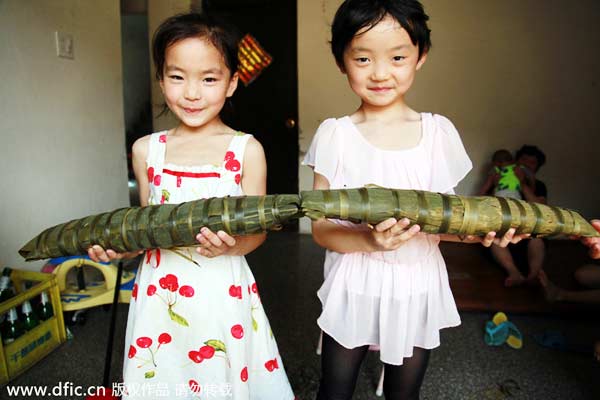
The types of Zongzi, glutinous rice wrapped in reed leaves, are as varied as the many regional cuisines, with different shapes and fillings, although they are almost always made of sticky or glutinous rice.
Almost all Chinese festivals are linked to foods, and many have stories behind them. The origin of zongzi, rice dumplings wrapped in leaves, is most often linked to Qu Yuan.
He was a poet and a patriot who lived during the turbulent Warring States Period (475-221 BC). When the kingdom of Qin occupied his home, the kingdom of Chu, Qu threw himself into the Miluo River in protest.
It was said that the people of Chu dropped rice balls into the river to stop fish and shrimp from eating his body.
Later, a fisherman said he dreamed that Qu told him dragons had been eating most of the rice balls, so the people wrapped the rice balls with chinaberry leaves, and tied them up with colorful threads. They would row in the river and throw in the dumplings on the fifth day of the fifth lunar month, the day Qu died.
The types of zongzi eaten in China are as varied as the many regional cuisines, with different shapes and fillings, although they are almost always made of sticky or glutinous rice.
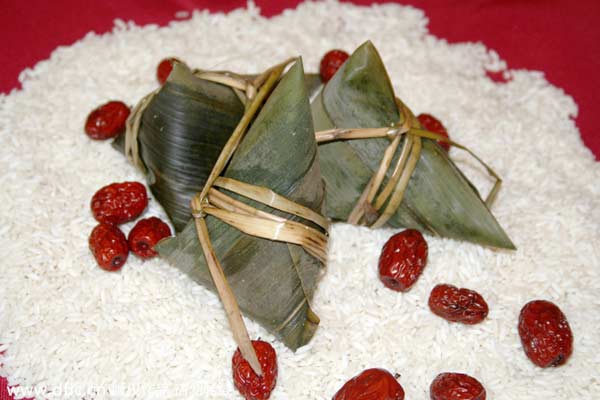
Zongzi stuffed with dried Chinese red dates.
In Beijing, they are most commonly stuffed with a candied or dried jujube, the dried Chinese red date. Some zongzi are left plain, to be dipped into sugar. Other places in North China replace glutinous rice with glutinous yellow millet, and these days, some folks replace white glutinous rice with purple rice.
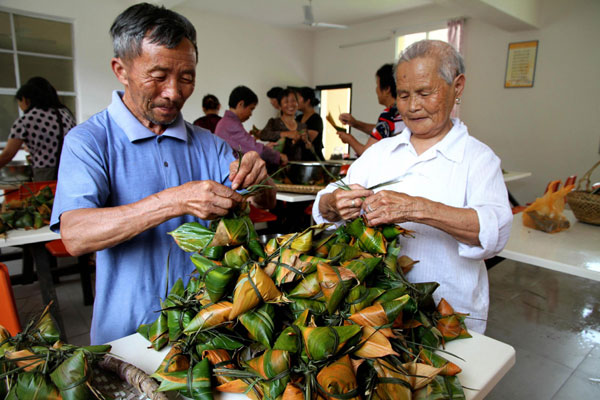
People make zongzi to welcome Dragon Boat Festival at a nursing home in Jing'an county,East China's Jiangxi province, June 8, 2013.
But the huge variety of zongzi south of the Yangtze River makes zongzi so much more a South China food. Other than jujubes, southern dumplings are stuffed with ham, braised pork, salted egg yolk, chestnut, fragrant mushroom, barbecued pork, and the ubiquitous red bean paste.
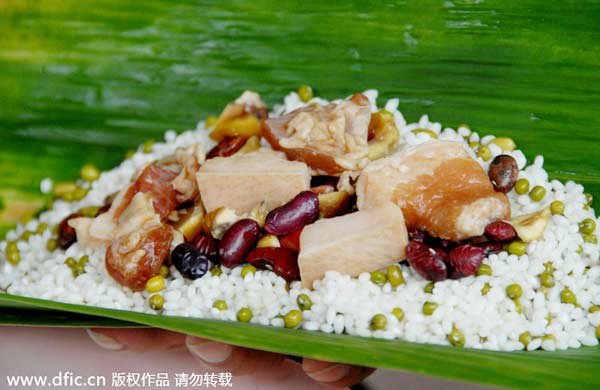
The ingredients inside a Guangxi-style zongzi.
In some parts of Guangdong and Fujian provinces, and Guangxi Zhuang autonomous region, people soak the glutinous rice in alkaline water, which gives the rice a honey-colored glaze and a softer texture.
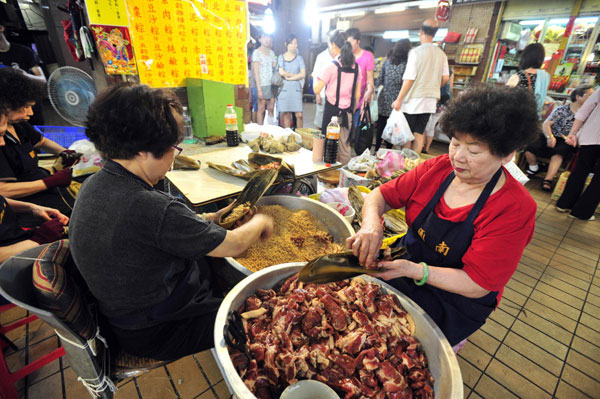
Shop assistants make zongzi with fresh ingredients at a local market in Taipei, Taiwan, June 8, 2013.
People in Sichuan province make a spicy zongzi with chili powder and preserved pork while in Suzhou, Jiangsu province, the locals put a piece of pork fat into the dumpling to give it a special aroma.
In Hainan, zongzi are wrapped in banana leaves, while dumplings on the mainland are wrapped in either bamboo or reed leaves.
Over on the island of Taiwan, zongzi are made with fried glutinous rice and fried pork, as well as bamboo shoots, dried mushroom and dried bean curd.
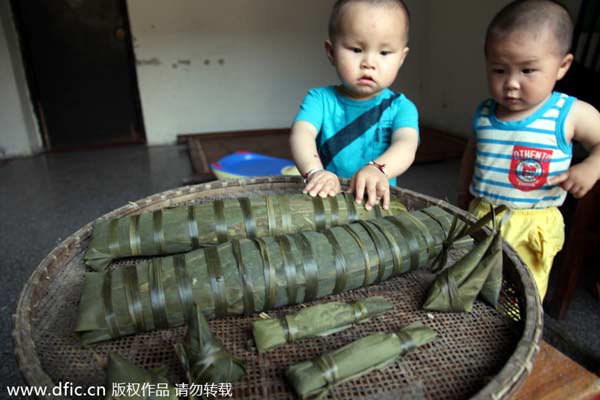
The longevity zongzi in Zhejiang province.
But the most famous zongzi in China are those from Zhejiang's Huzhou and Jiaxing, and these have become the national standard.
In Huzhou, salty zongzi are made with fresh pork flavored with soy sauce, while sweet zongzi are made with jujube or red bean paste, with a piece of pork fat added to make the paste even more aromatic.
Jiaxing zongzi use chicken and "eight treasure" stuffing, as well as the more common red bean paste and preserved duck egg yolk.
But fresh pork zongzi is the most popular.
The meat is taken from the hock and marinated with sugar, salt, soy sauce and baijiu (Chinese liquor) to give it plenty of flavor. It is then wrapped in bamboo leaf and boiled.
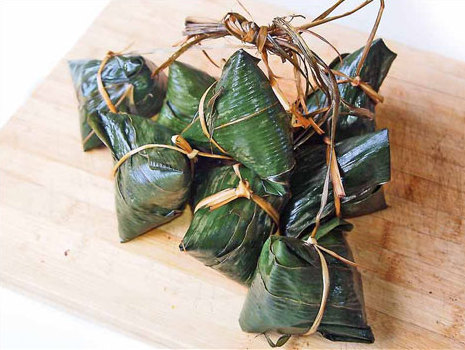
Recipe | Savory rice dumplings
Ingredients (makes about 30):
1 kg glutinous rice, soaked and drained
1 kg pork belly
200 g dried Chinese mushrooms, soaked
300 g ready-to-eat chestnuts
200 g dried prawns
500 g red bean paste (dousha)
50 g dried chilies
300 g garlic, minced
1 3-cm piece ginger
1 medium brown onion
2 tsp pepper
1 tsp five-spice powder
300 g shallots
1 tsp salt
2 tbsp oyster sauce
3 tbsp light soy sauce
3 tbsp dark soy sauce
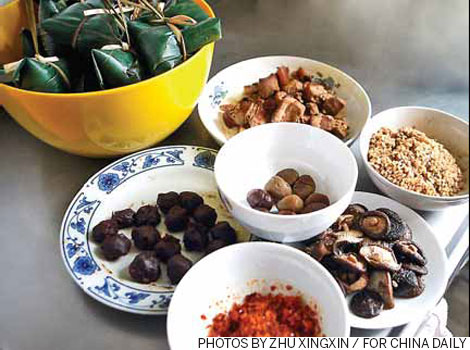
Method:
1. Prepare spicy prawn paste. Pound the dried prawns in a pestle and mortar until fine. Grind together dried chili, ginger, garlic and onion and add to pounded prawns.
2. Heat up some oil in a wok and fry the mixture until fragrant.
3. Peel and slice the shallots and fry in oil over low heat until fragrant and crisp. Set aside.
4. Blanch the pork belly in boiling water for five minutes. Remove from heat and cut into smaller chunks.
5. Marinate the pork belly pieces in the light and dark soy sauce, minced garlic, pepper and five-spice powder. Leave to season for an hour or longer.
6. Place the marinated pork over low fire and cook for 15 minutes. Drain and set aside the gravy.
7. Add the glutinous rice to the gravy in the pan and fry and mix well. Take the rice off the fire and mix in the crispy fried shallots.
Art
 more
moreChina Beijing International Diet ...
Recently, The hit CCTV documentary, A Bite of China, shown at 10:40 ...

Exhibition of Ancient Chinese Jad...
At least 8,000 years ago, Chinese ancestors discovered a beautiful...

Longmen Grottoes
The Longmen Grottoes, located near Luoyang, Henan Province, are a tr...

Custom
 more
moreWeb Dictionary
Martial Arts
Tai Chi Master Class Held in Moscow
MOSCOW, June 15, 2016 (Xinhua) -- Students learn from Shaolin ...
Celebriting 70 years' efforts in restoring Mogao...
Work is being carried out at the restoration site of cave No 98 a...
Hong Kong Children's Symphony performs in Seattle
Under the theme of Tribute to the Golden Age, a concert featuring a ...





 print
print  email
email  Favorite
Favorite  Transtlate
Transtlate 








